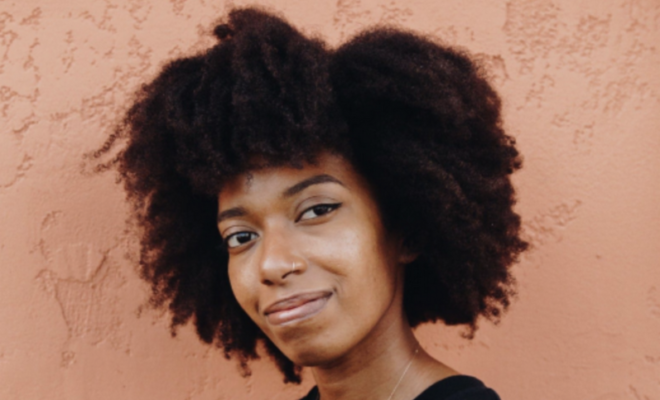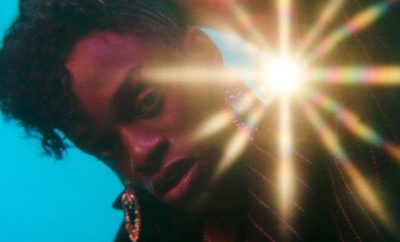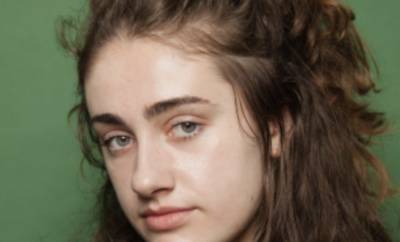
Interviews
Olivia Peace – Tahara
By: Lisa Steinberg
Q) It’s not often we see this type of teen angst-based film. Normally it’s set at a party, or school, especially with the focus that’s within this particular film where it’s set within the religious complex of a synagogue. When you first heard about the film and were approached about working on it, what really struck you about it and drew you to the project?
A) The thing that drew me to the project initially is that I was reading through the script with my roommate and got to the scene where Hannah (Rachel Sennott) pops the zit in the mirror and I felt so strongly in that moment that, “If I directed this, I would want to see the zit burst.” So, suddenly I found myself having all of these suggestions and I hadn’t even said yes to it. The next day I talked to Jess [Zeidman] on the phone and kind of brought up all of these ideas at the time. I already knew that I wanted to animate some of the interior emotional experiences like when Hannah is thinking about Tristan (Daniel Taveras) or when Carrie (Madeline Grey DeFreece) is thinking about Hannah. I knew that kind of straight out. I knew that I wanted to try for a 1:1 aspect ratio that was just totally based on Instagram, and at the time I hadn’t seen it in other films that was shot that way. I think I even had a whole list and I was going line by line and Jess just kept saying “yes.” By the time we got to the end of all of my suggestions, I was like, “Oh no, I think I have to do it.” She was just so gracious with opening the script up to all of these different forms of collaboration. I know it meant a lot to her the actual story side of the script and allowing all of these different people to put their spin on it. That’s kind of how we got there. But you’re right, it is pretty rare that we see teens in these more serious church settings, let alone a funeral. That was a pretty big part of my coming up as a teen. Both constantly being in these religious scenarios in youth groups and stuff like that. I think my generation of millennials was the first where they started to call it a suicide epidemic. It was quite odd that we don’t have more media about that just yet but for sure it’s coming.
Q) The start of the film is an Insta identifier (the 1:1 aspect ratio). Nowadays it’s not news or didn’t happen unless you have Insta’d it. Our Insta footprint is everything. Talk about how the films Insta footprint is like a pathway to the focus within the film.
A) I mean, a lot of the research that I did in preparation for this film, along with talking with people that I knew, was looking and starting to follow teens on TikTok and Instagram to just get a better sense of how teenagers are talking these days. One of my big pet peeves when people write for teens and make content about teens is that they cast these old people and then are kind of talking about a teenage experience that they remember. No matter how long ago that was it ends up not feeling sincere for the time that we are in right now. So, I did a lot of research on that.
Having a social media footprint is very crucial it seems to a lot of teenagers right now. I would imagine even especially more so now that we are all inside and all you are seeing of your friends is their social media profile. With the 1:1 aspect ratio for me, a thing that I noticed was having your frame be narrower like that makes the character feel a lot more isolated is you can only fit about one and a half people in the frame as it is since it’s so small. A lot of the shots are just singles with one person, which makes them feel very separate from all of the action that is going on, and I think that is how I felt a lot of the times as a teen. A lot of the awkwardness and the drama gets played up because you can’t see the reactions of the other people in the room while you are watching the film. Beyond that, it’s just kind of this very zoomed in perspective and being hyper focused on whatever so-and-so said over there or the action shot of Tristan or even just looking at the food.
Q) The visceral imagery and artistry with claymation and hand drawing that juxtaposes with the live action of the film scenes adds another layer and these shocking and transitional scenes which is like a small look into the characters’ mind. How did you incorporate while keeping up the pace/flow/rhythm with such naturalness?
A) That is a collaboration I think between three people, one being my editor Troy [Lewis] and then our animator Emily Ann Hoffman and myself. I actually learned how to direct from being an animator originally when I was in film school. I always liked animation because you could make really whatever you wanted to as a team of one. You don’t need the big crew or fancy camera or all of these actors even. You can just kind of figure it out and make it happen. I think with animation it’s changed a lot now, but for a while the animation was just seen as something for children in this country. I always experienced it as something that had kind of unlimited potential, especially when it comes to expressing emotions or more abstract ideas. It just felt really right to have the animated scenes used specifically and strategically for having people’s interior lives portrayed on screen. Troy did an amazing job of editing that together so that it made sense. Emily did a really great job of working with me to design the characters and figuring the specific styles that everybody used for Hannah’s interior and then for Carrie’s style.
Q) We see this facade of grief that balances between melancholy and levity in two different breaths. As we shift into the more intense moments, we see the tones fluctuate and the colors absorb and reflect a lot of the emotion that is being portrayed on screen. Talk about how the lighting helps play to the tones and adds to the emotional engagement that we see.
A) I love talking about color! When I think about a film that I am trying to make one of the first things I think about is color. This time I got super lucky and our cinematographer Tehillah De Castro introduced me to these amazing colors and I showed him all of these samples of the type of color grades that I had in mind and Tehillah kind of already knew what I had in mind as well. I wanted this to look serious. I wanted it to look like a serious film! I think when it comes to teenagers, teen films have a certain kind of pop aesthetic, which is nice but I kind of wondered what would happen if I colored this like a Coen Brothers movie. This specific color that we had was this sort of navy blue/green/yellow. Part of it was the pallet I had designed, but when we got into the space, the synagogue already had those colors everywhere, so it was perfect. Our costume designer and our production designer added extra flairs to help bring everything together. I really like how the color turned out. I think it sort of has that serious factor tone to it, but I really love how the sanctuary came out in particular. The light is coming through the stained glass. I really also wanted to show off the beauty of the space. I think we did an amazing job of kind of splitting the difference there.
Q) I had read that it was a fifteen-day shoot for you with this film and yet there are these amazing details and great intricacies that are also really important to the story telling aspect. As much as you story boarded, how did the fifteen days shift those plans and how were you able to accomplish all of these great details in such a short period?
A) It was really a stretch, and we didn’t have any rehearsal time either. Our cast got there the night before it was time for them to shoot. I think some of it was luck. Like Maddie and Rachel our two leads getting along so well and being actual legitimate friends was really lucky. A lot of it also is preparation.
Tehillah and I went through and really meticulously shot listed and story boarded as they say, then we did a trip to Rochester before the shoot to make sure that our story boards and shot list were actually aligning with the space. We talked a lot with the actors about the characters that they were playing and they all had these super elaborate backstories. In terms of the costuming, Avery [Ginsberg] our costume designer is an actual fashion designer as well. Some of the pieces in the film are from his own personal lines and collections which is really cool to have. My favorite piece was Tristan’s giant suit. We spent a lot of time going to find the perfect items. Part of the costuming was telling some of the backstory. One of the things that Avery and I decided was that Hannah would wear a homecoming dress to the funeral. That was sort of the thing that we would be hunting for. It was really tough though. [laughs]
I kind of don’t recommend having fifteen days. I will say one of the other saving graces was we had our editor Troy Lewis on set editing as we went. Because this was a lot of people’s first features, including mine, it really helped to have him there to let us know what is coming together and if things are working already by the next morning, we would be able to start each day looking at the dailies the night before. Our first day our first shoot actually ended up looking terrible, so we were able to see that immediately and then go and schedule to do it over because that was going to be the opening to our film. But, yeah, it kind of takes a while for the crew to get to know each other and start gelling. On top of everything, our synagogue was under construction the entire shoot so sometimes we would be in the middle of a shot and we would hear drilling happening or hammering or we would think that today they are going to be in this area and instead now they are in the hallway out with us and now we have to rearrange our schedule. It was pretty tough, but I think after a couple of days we really fell into the swing of things.
The other thing is that obviously we couldn’t shoot on Saturdays, so we had to stop early on Fridays as well. Then, there was Sunday school on Sunday, so we had to kind of work around these things. We ended up really getting exactly what we needed and literally nothing else. We used pretty much everything that we shot.
Q) What did you really take away from working on the project and hope that the film evokes for viewers as well?
A) I think for me, this film really helped me become a better person. It helped me become a better director and leader. It helped me learn how to try and handle conflict a lot better, but also have a lot more confidence in my artistic style and the way that I make things. A lot of what this film is is the really hard work of other people, so I want to share that with everyone.
What I hope people take away from the film is that I hope people feel seen by it. I love hearing how much you connected with it. I have gotten really sweet emails from people who have felt the same way. That just brings me so much joy because that’s what it is for. It’s such a shame that people often don’t see their experiences accurately portrayed and I think that has an effect on how we act in real life. If we are not seeing that anywhere it’s kind of hard to have empathy for yourself in a way. I got a really sweet message from someone talking about how they recognized the gaslighting scene as something that they directly experienced. Seeing it happen to Carrie made it more real than when it happened to them. I hope people feel seen by it.





You must be logged in to post a comment Login